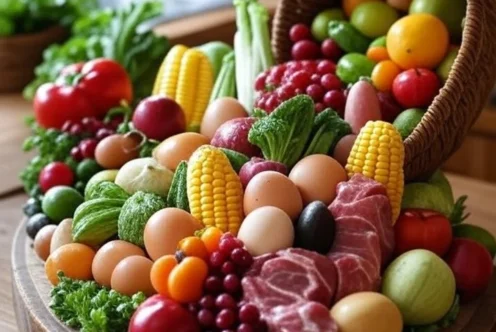Blog
What Are Local Food Movements: Here’s the Lowdown

Local food movements have gained significant traction in recent years, as communities across the globe strive to reconnect with their food sources, support local economies, and promote sustainable agricultural practices. At their core, local food movements emphasize the production, distribution, and consumption of food within a specific geographic region, often prioritizing small-scale farmers, direct-to-consumer sales, and environmentally friendly practices.
These movements work to foster a deeper connection between people and the food they eat, while addressing issues like food security, and community resilience.
In Arizona, a state known for its diverse agricultural heritage and unique desert climate, local food movements are thriving through direct market farms, farmers’ markets, and community-supported agriculture (CSA) programs. This article explores the essence of local food movements, their significance, and how Arizonans can engage with these initiatives to support local farmers and enjoy fresh produce.

Understanding Local Food Movements
Local food movements are grassroots efforts to prioritize food production and consumption within a defined region, typically within a 100- to 400-mile radius of where the food is grown or produced. These movements encompass a variety of practices, including:
- Direct Market Farms: Farms that sell directly to consumers through farmers’ markets, farm stands, CSAs, or on-farm sales, bypassing traditional intermediaries like wholesalers or large grocery chains.
- Farmers’ Markets: Community-based markets where local farmers and producers sell fresh produce, meats, dairy, baked goods, and artisanal products directly to consumers.
- Community-Supported Agriculture (CSAs): Programs where consumers purchase “shares” of a farm’s harvest in advance, receiving regular deliveries of fresh produce throughout the season.
- Farm-to-Table Initiatives: Restaurants and institutions that source ingredients directly from local farms to create fresh, seasonal menus.
- Food Hubs and Co-ops: Organizations that aggregate and distribute local food to make it more accessible to consumers, schools, and businesses.
The goals of local food movements are multifaceted. They aim to:
- Support small-scale farmers by ensuring they receive a fair share of the food dollar.
- Reduce the environmental impact of food production by minimizing transportation and promoting sustainable farming practices.
- Enhance food security by creating resilient, localized food systems.
- Foster community connections by bringing farmers, producers, and consumers together.
- Promote healthier eating by providing fresh, nutrient-dense foods.
In Arizona, local food movements are particularly important due to the state’s unique agricultural challenges, such as water scarcity and extreme temperatures, as well as its rich tradition of native crops like tepary beans, mesquite, and prickly pear. By supporting local farms and markets, Arizonans can contribute to the sustainability of their food system while celebrating the state’s diverse culinary heritage.
Local Food Movements in Arizona: The Role of Direct Market Farms
Arizona’s local food movement is vibrant, with direct market farms playing a pivotal role in connecting farmers with consumers. These farms, often small-scale and family-operated, focus on sustainable practices. According to the Arizona Community Farmers Markets, participants in their markets are required to be local direct producers, meaning they grow or produce the goods they sell, ensuring authenticity and traceability.
Key Features of Arizona’s Direct Market Farms
- Diverse Offerings: Arizona’s direct market farms offer a wide range of products, from traditional produce like tomatoes, lettuce, and zucchini to native and heirloom crops like tepary beans and prickly pear fruit. Markets also feature grass-fed meats, farm-fresh eggs, raw honey, and artisanal products like jams, salsas, and baked goods.
- Sustainable Practices: Many Arizona farms prioritize organic methods, aligning with consumer demand for this method of farming. The Sedona Farmers Community Market, for example, requires growers to adhere to USDA Good Handling and Good Agricultural Practices (GHP/GAP), ensuring high standards of safety and sustainability.
- Community Engagement: Direct market farms foster community connections by providing spaces for consumers to meet farmers, learn about food production, and engage in educational programs. Initiatives like the Arizona Food Summit and Farm to School programs further strengthen these ties.
- Economic Impact: By selling directly to consumers, farmers retain a larger share of the food dollar, often 80% or more compared to just 14% to 20% when selling through grocery stores. This direct-to-consumer model supports local economies and helps small farmers thrive.
Notable Arizona Direct Market Farms and Initiatives (List is not all inclusive)
- Mortimer Farms (Dewey Humbolt): The story of the founders, Gary and Sharla Mortimer unfold against a backdrop of farming and ranching heritage. Both Gary and Sharla come from agricultural backgrounds, with Gary growing up on a corn and soybean farm in Iowa, while Sharla experienced life on a cotton farm in Arizona. Their shared love for the land and their desire to instill the values of hard work and a deep appreciation for food cultivation in their family laid the foundation for their journey.
- Marana Pumpkin Patch (Marana): Marana Pumpkin Patch has 50 acres of homegrown pumpkins (courtesy of Post Farms) so you can find your own personal favorite to take home. Walk through the patch and explore, as you find large ones, small ones, and ones that suit you just right!
- Schnepf Farms (Queen Creek): Home to the Queen Creek Family Market, Schnepf Farms offers a relaxed atmosphere where families can shop for local produce, enjoy food trucks, and participate in community events.
- Sun Produce Co-Op: This multistakeholder cooperative creates alternative distribution streams for small-scale Arizona producers, reducing barriers to market entry and leveraging cooperative branding.
- Tolmachoff Farms (Glendale): Tolmachoff Farms is a unique fourth-generation family farm operated in Glendale, Arizona. The farm originally grew cotton, wheat and corn in the first part of this century. They started selling plums in the early 1970’s from a roadside stand and the pick your own farm fresh produce stand has continued to grow ever since. They grow a large variety of fruits and vegetables and strive to provide you and your family with the ultimate in fresh produce straight from the field to your table.
- Tucson Farmers’ Markets: Tucson boasts year-round markets with native crops and heirloom varieties, such as those at the San Xavier Co-op Farm and Mission Garden Project.
- Downtown Phoenix Farmers Market: A hub for urban dwellers, this market features over 200 products, including fresh produce, baked goods, and handcrafted items, with options for curbside pickup and delivery.
To discover more direct market farms, go to fillyourplate.org and search the database that says, Farms to Visit.
Challenges and Opportunities
Arizona’s direct market farms face challenges like water scarcity, high temperatures, and available labor. However, opportunities abound through programs like the Arizona Farmers Market Nutrition Program (AZFMNP), which provides coupons to eligible seniors and WIC participants to purchase fresh produce. Additionally, the Double Up Food Bucks program doubles SNAP benefits for fresh fruits and vegetables, making local food more accessible.
Tips for Maximizing Your Trips to Arizona Farmers’ Markets
Farmers’ markets are a cornerstone of Arizona’s local food movement, offering fresh produce, unique products, and a chance to connect with the community. Here are practical tips to make the most of your visits:
Plan Ahead:
- Check market hours and locations in advance, as they vary by season. For example, the Downtown Phoenix Farmers Market operates Saturdays from 7:30 a.m. to 11:30 a.m., while the Gilbert Farmers Market adjusts hours from 8 a.m. to noon in cooler months to 7 a.m. to 11 a.m. in summer.
- Use online directories like Fill Your Plate (fillyourplate.org) Good Food Finder (goodfoodfinderaz.com) or the AZFMNP website (azfmnp.org)
- Review vendor lists on market websites or social media to know what’s available and plan your shopping list.
Shop Early:
- Arrive early to get the best selection, as popular vendors often sell out quickly. Early shopping also ensures fresher produce and shorter lines.
- For example, at Pinnacle Peak Farmers Market, early birds snag fresh flowers, handmade soaps, and seasonal specials before they’re gone.
Bring Reusable Bags and Cash:
- Many vendors accept credit/debit cards or EBT, but cash is still king for small transactions. Bring small bills for convenience.
- Reusable bags or baskets help carry your haul and reduce waste. Some markets, like Roadrunner Park, are wheelchair and stroller accessible, so plan accordingly.
Buy in Season:
- Purchasing in-season produce ensures the best flavor, nutrition, and price. Arizona’s year-round growing season means you’ll find citrus in winter, melons in summer, and root vegetables in fall.
- Ask vendors about seasonal specials or bulk discounts to maximize value.
Engage with Vendors:
- Talk to farmers about their growing methods, recipes, or storage tips. This builds relationships and deepens your understanding of local food systems.
- For example, at the Sedona Farmers Market, vendors offer insights into organic practices and native crops like mesquite flour.
Explore Beyond Produce:
- Arizona markets offer more than fruits and vegetables. Look for local honey, grass-fed meats, artisanal cheeses, and gluten-free baked goods.
- Markets like Uptown Farmers Market feature food trucks and ready-to-eat items like jerk chicken sandwiches or tamales.
Support New Vendors:
- Many local food trucks and businesses start at farmers’ markets. Supporting them helps grow the local economy and may lead to discovering new favorites.
Do’s and Don’ts at Arizona Farmers’ Markets
To ensure a positive experience for yourself, vendors, and other shoppers, follow these guidelines:
Do’s
- Do Arrive Prepared: Bring reusable bags, cash, and a list to stay organized. Check the market’s pet policy—many, like Gilbert Farmers Market, are pet-friendly.
- Do Ask Questions: Engage vendors about their products, farming practices, or recipe ideas. This enhances your experience and supports their efforts.
- Do Be Respectful: Follow market rules, such as maintaining social distancing or adhering to weather policies (e.g., rain or shine at most markets, except in dangerous conditions).
- Do Explore Activities: Bring kids to enjoy games, face painting, or educational events, like those at Spaces of Opportunity Farmers Market.
Don’ts
- Don’t Haggle Excessively: While some negotiation may be acceptable, respect the farmers’ pricing, as they rely on direct sales for their livelihood.
- Don’t Waste Food: Only buy what you can use to avoid spoilage. Ask vendors for storage tips to keep produce fresh longer.
- Don’t Ignore Rules: Follow market-specific guidelines, such as no smoking or proper pet behavior, to ensure a pleasant environment for all.
- Don’t Arrive Late: Popular items sell out quickly, so don’t miss out by arriving near closing time.
- Don’t Overlook Accessibility Programs: If eligible, use SNAP, WIC, or Double Up Food Bucks to make your dollars go further.
Conclusion
Local food movements are more than just buying food, they’re about building connections, supporting sustainable practices, and celebrating the unique flavors of a region. In Arizona, direct market farms and farmers’ markets like those in Phoenix, Tucson, Sedona, and Queen Creek are at the heart of this movement, offering fresh, local, and often organic products that reflect the state’s agricultural diversity. By shopping at these markets, Arizonans can support small farmers, strengthen their communities, and enjoy nutrient-dense, flavorful food.
By following the tips and do’s and don’ts outlined above, you can make the most of your farmers’ market visits, ensuring a rewarding experience for yourself and the vendors who work hard to bring fresh food to your table. Whether you’re savoring a prickly pear jam from a Tucson market or picking up farm fresh eggs at the Uptown Farmers Market, you’re contributing to a vibrant, sustainable food system that benefits all Arizonans.
So, grab your reusable bags, head to your local market, and discover the lowdown on Arizona’s local food movement!


















